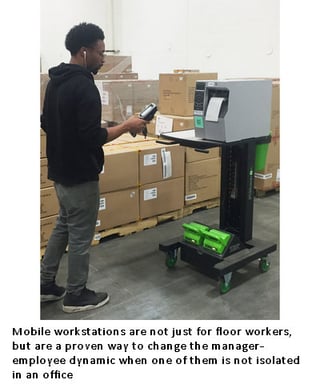
Warehouses have been evolving for years, and the past few have been no exception. In an era impacted by a deadly pandemic, warehouses are among the rare businesses that experienced a surge in demand for workers, making it more important than ever for employers and managers to motivate their existing staff.
Warehouse employment has reached new highs as eCommerce sales have skyrocketed over the past several years. The U.S. Census Bureau reports that U.S. eCommerce sales for 2020 jumped 32.4% over the prior year, largely driven by consumer reactions to COVID-19. This is not only put a major strain on warehouses but also amplified already existing labor issues in this industry.
Businesses of every stripe struggle at creating an engaged workforce. This is a particular challenge, however, for warehouses and third-party logistics (3PL) companies. But warehouse worker engagement can have massive payoffs, so it’s worth the effort to make improving this aspect of your business a priority.
Warehouse Labor Management an Ongoing Challenge
 A recent LinkedIn report reveals that eCommerce-related jobs (including warehouse staff) are currently the most in-demand positions, with a hiring increase of 73% year-over-year. The Bureau of Labor Statistics reports that warehouse employment reached its highest level on record in November 2020 at 1.43 million workers, compared to 1.11 million two years prior.
A recent LinkedIn report reveals that eCommerce-related jobs (including warehouse staff) are currently the most in-demand positions, with a hiring increase of 73% year-over-year. The Bureau of Labor Statistics reports that warehouse employment reached its highest level on record in November 2020 at 1.43 million workers, compared to 1.11 million two years prior.
Even with impressive employment numbers, turnover in this industry is just as high. A report from the International Association of Refrigerated Warehouses noted that turnover was an average of 32.5% in 2018, before the pandemic. The Seattle Times analyzed Amazon employee turnover between March 1 and September 19, 2020, revealing a stunning 111% rate.
This results in a challenge for warehousing businesses to either continuously hire fresh staff to keep operations moving or find ways to engage and retain the staff they have. Many warehouse businesses are increasingly interested in ways to make their businesses run more efficiently, which includes improving worker engagement.
Why Warehouse Worker Engagement Matters
It’s no secret that warehouse work is demanding, repetitive, and labor-intensive. Workers must look out for hazards to avoid common accidents and injuries. For management, it’s a continuous challenge to keep workers motivated and engaged in such an environment.
In a recent Warehouse Vision Study by Zebra that surveyed over 1,400 operational decision-makers, 60% reported labor recruitment and/or labor efficiency and productivity among their top challenges. Another report by Kronos on the manufacturing industry revealed that only 7% of companies believed their employee productivity was very strong. And 72% of respondents believed that lack of employee engagement was the cause of poor productivity.
The need to increase employee engagement is strong. Why? Because the benefits translate to much more than smiling staff in your warehouse’s breakroom. Engagement correlates with higher rates of productivity, customer satisfaction, and profitability.
By committing to a program of engagement, your business has the opportunity to significantly reduce employee absenteeism and turnover, safety incidents, and product or warehouse mistakes. Korn Ferry, a management consulting company, reports that organizations with strong employee engagement scores generate up to 4.5 times higher revenue growth than companies with lower scores.
It would be tough to find other areas of your business that would produce as many positive results as employee engagement. This explains why 85% of global business leaders rank engagement as a top priority, according to Deloitte.
Ways Improve Worker Engagement in the Warehouse
Many factors can act as barriers to meaningful manager-worker engagement. These include job market unease, organizational tumult, a lack of cohesion among workers, and distrust of management.

But organizations that try to buy engagement and commitment might be disappointed. Of course, you need to pay your employees a fair wage and offer competitive benefits. But engagement experts agree that higher pay alone won’t truly drive the enthusiasm and extra effort that comes with job satisfaction. The good news is there are some ways to improve worker engagement in the warehouse that will produce results. Here are a few:
1. Give Individual Attention
When it comes down to it, employees in your warehouse just want your attention. That’s not to say your staff wants a hovering micro-manager. But, rather most employees prefer a manager that is visible to some extent.
If your warehouse management is accustomed to sitting in an office and sending out directives, this probably needs to change. There should be a commitment to spend more time on the floor with staff to make connections, identify ongoing challenges, and serve as an example.
2. Provide Coaching and Training
Coaching and training are other key ingredients for employee engagement. When your warehouse creates a culture of continuous development that helps employees improve their skills, it also communicates that it believes in their potential and values their contribution.
Fortunately, you don’t have to have a massive training budget to accomplish this. In addition to thorough onboarding training, consider offering cross-training opportunities so that employees can learn other positions and get prepared for advancement.
3. Recognize Good Work
It’s not a secret that recognition and rewards can boost employee engagement. First, have managers let your staff know the importance of their work and how it fits in with the organization’s overall mission. But it’s also important to outline what type of behavior will be rewarded and then formally recognize employees who deliver results.
4. Get Social & Involved
A simple way to help employees feel more invested in their work is to foster closer connections with staff and build strong teams. There are plenty of low-cost options to bring people together, such as employee picnics and potlucks. You can also cultivate that sense of purpose and belonging by helping employees give back to the community through different service projects.
5. Listen to Employees
Effective warehouse managers pay close attention to what their workers have to say and then act on the feedback they receive. Instead of having annual employee surveys, it should be a practice for managers to regularly engage employees in conversations about workplace challenges and ask for insights on ways to solve ongoing issues. When employees feel that they are being heard, they will continue to be more engaged.
6. Supply the Right Tools
One of the most important drivers of warehouse employee engagement may also be one of the most overlooked - ensuring employees have the best tools possible to do their work. According to Deloitte, giving employees tools and processes for success is referred to as “enabling infrastructure,” and it’s a top driver globally for engagement.
Warehouses are incredibly complex environments, so there can be plenty of frustrating barriers to getting things done efficiently. When management expects employees to adapt to and work around challenges instead of providing the best solutions available, this doesn’t inspire confidence.

Some of the trends in warehousing point to partial automation with augmentation, which involves equipping workers with technology and devices to make work easier and more efficient. For example, having a mobile-powered workstation on the floor instead of in an office brings the warehouse manager and employee closer together, fostering higher levels of engagement. It also reduces worker fatigue, eliminates costly footsteps, and improves accuracy and efficiency.
Engagement is often a term that is tossed out as a priority without enough thought into its implications or how to achieve it. For warehouses, investing in manager-worker engagement on a consistent basis is necessary for short and long-term business success.










